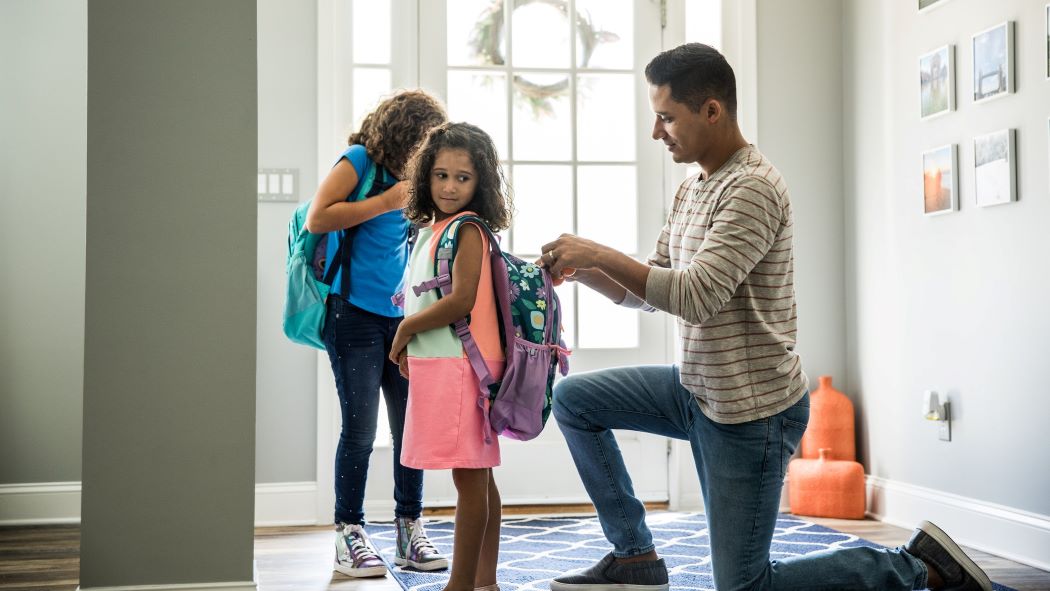Dr. Leslie Barakat, a pediatrician and senior medical director for Cigna, has advice about keeping children as safe as possible now that they are back in the classroom.

Heading back to school after the summer ends is always a time of adjustment for children, whether they’re starting a new grade, a new school, or both. It’s a time of adjustment for parents and other guardians as well – and two-plus years into the COVID-19 pandemic, they still have plenty of health and safety concerns to think over, plan for, and worry about.
With that in mind, we asked Dr. Leslie Barakat, a pediatrician and senior medical director for Cigna, for advice on keeping children as safe as possible, at school and elsewhere.
How can I assess my child’s COVID risk at school?
Understanding what’s going on in your area is a key to making informed decisions about risk at school and elsewhere in your community. A good source of information is the Centers for Disease Control and Prevention’s (CDC’s) COVID-19 Data Tracker, which uses a color-coded map to show the level of COVID transmission in every county or city across the United States. For example, 39.6% of counties had a high COVID-19 community level as of August 11, 2022, while 40.7% had a medium level and 19.8% had a low level.
Throughout the summer, we saw COVID-19 omicron variants emerge, causing regional spikes in outbreaks. Although immunity through vaccinations and natural infections has created a relatively high level of protection against serious disease and hospitalization, new variants may circumvent protection and cause new infections, so it’s important to stay informed.
Children, in general, are at less risk than older individuals for serious complications. However, they could be at more risk for serious disease if they have certain chronic conditions or a weakened immune system. The chances of becoming very sick or dying from COVID increase with age and underlying medical conditions, including cancer, diabetes, heart conditions, dementia, and obesity, particularly when people are not up to date on COVID vaccinations. People with immune deficiencies, some disabilities, some mental health conditions, and some chronic diseases are also at higher risk.
What can I do to reduce my child’s COVID risk?
The single most effective way to protect our children is to make sure they are up to date on all of their immunizations. We've seen a decline in vaccination rates nationally and are concerned about potential outbreaks of life-threatening diseases. The recent case of polio reported in New York reminds us that we cannot let down our guard. We also know that people vaccinated against viruses such as COVID and influenza (flu) are much less likely to have a severe illness or be hospitalized if they do get sick, compared with those who are unvaccinated.
The American Association of Pediatrics (AAP) recommends COVID vaccination for everyone 6 months and older. Children should get fully immunized – receiving the first two doses – as soon as they are eligible. Children who are 12 or older are now eligible for Pfizer’s new COVID vaccine, which targets the omicron variant and was authorized by the FDA on August 31. The FDA also authorized Moderna’s new booster, but only for adults 18 and older. The new boosters can be administered two months or longer after completing the first two vaccine doses or receiving a booster.
In addition, protect others by keeping your children and teens home from school if they are sick or show new symptoms, and continue to emphasize handwashing.
Should my child wear a mask in the classroom?
Ideally, schools should stay informed about community transmission levels and require masks when community transmission rates are high. Even if the school does not require indoor masking, it’s still a good idea for your child to wear a mask indoors, especially if your child is currently ineligible for the COVID-19 vaccine; is unvaccinated; is immunocompromised; if a family member is at high risk; or if you live in a community with high COVID transmission. For maximum protection, use snug, well-fitting masks that cover the nose and don’t gap around the sides.
What about sports and other school (or non-school) activities?
The AAP offers guidance for parents of children and teens participating in sports, physical education classes, and other physical activities. In general, indoor settings have greater risks than outdoor activities, while the number of players, how close they are together, and the amount and duration of contact all are risk factors for COVID transmission.
Wrestling, ice hockey, and basketball probably put players at the highest risk, the AAP concluded. Other sports might be less risky while in process, but activities such as team meals and transportation in private vehicles can put unmasked or partially masked athletes at greater risk. If your community is having a high transmission rate, you probably will want to refrain from having your child participate in those types of activities.
The AAP recommends that local officials monitor conditions when considering whether a sporting event or practice should be canceled, delayed, or otherwise limited. It also notes that encouraging or requiring vaccinations, requiring face masks, and enforcing physical distancing can decrease the risk that players and others will contract COVID.
What else can I do to help ensure my children are safe and healthy, at home as well as at school and during activities?
Make sure your child gets a yearly check-up, which will include screening for mental health conditions. If your child will be playing a sport, be sure to get a pre-participation (sports) exam. Your pediatrician can help you update any forms your child's school may need in case of a medical emergency.
If you have health insurance coverage through Medicaid or the Children's Health Insurance Program (CHIP), check that your contact information is up to date with your state Medicaid agency. This will ensure you get timely updates about your health coverage so you can avoid any gaps in coverage.
Many children and teens have experienced mental health struggles over the past few years. It's important to let them know they can talk to you or other trusted adults about how they're feeling. Be alert to worrisome changes in behavior or any signs anxiety or distress. Try to prioritize family meals and exercise breaks, like taking walks together. These can be great opportunities to talk.
Ask your pediatrician if you are unsure if your child needs help or how to start a discussion. Schools may also offer sources of mental health support.
If you have a firearm in your home, make sure to lock it up and store the ammunition separately. The risk of suicide is higher for children and teens who live in a home where guns are stored loaded or unlocked.
The changes in routine that accompany back-to-school make it a good time to create or update your family media plan so you can help your child balance screen time with sleep, exercise, and other healthy activities. As part of your planning, help your children choose high-quality programs or games and teach them how to recognize sites that that promote false information.
Above all, as the AAP reminds us, remember that children are resilient. When they face issues, trusted adults like parents, educators, and their pediatricians can help them rebound and thrive. Pediatricians are available to help their patients’ parents as well, so don’t hesitate to reach out with questions or concerns at the beginning of the school year, or any other time of year.

Get News, Insights, and Inspiration Right to Your Inbox
Subscribe to our monthly newsletter today.